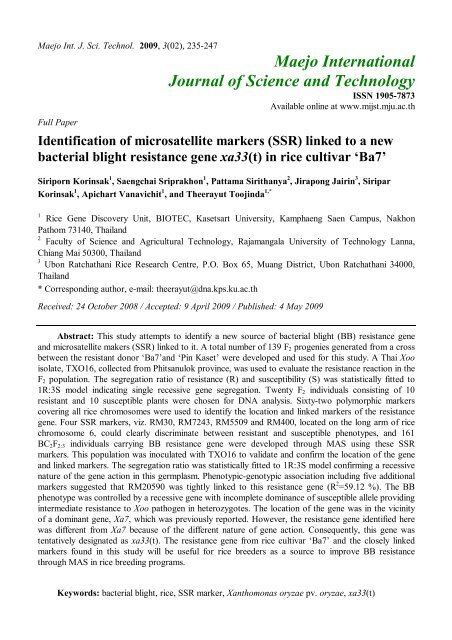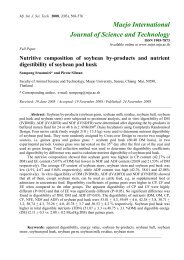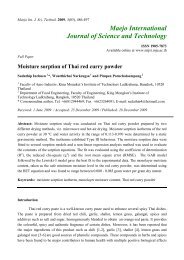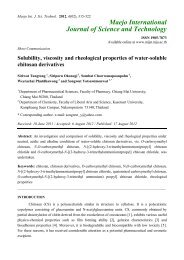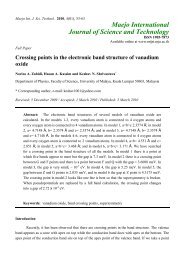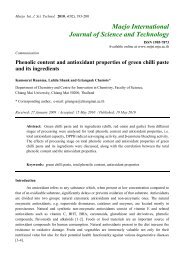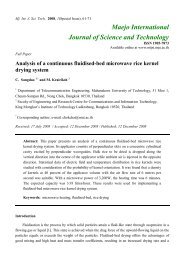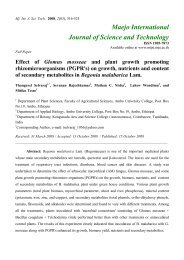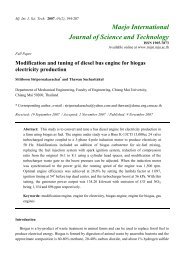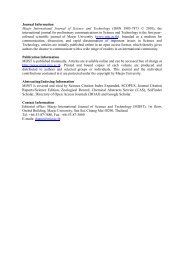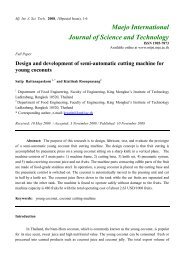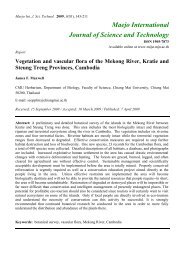(SSR) linked to a new bacterial blight resistance gene xa33 (t)
(SSR) linked to a new bacterial blight resistance gene xa33 (t)
(SSR) linked to a new bacterial blight resistance gene xa33 (t)
Create successful ePaper yourself
Turn your PDF publications into a flip-book with our unique Google optimized e-Paper software.
Maejo Int. J. Sci. Technol. 2009, 3(02), 235-247237amplified polymorphic DNA sequence (RAPD) markers [23-25]. In addition, simple sequence repeat(<strong>SSR</strong>) markers have been extensively used <strong>to</strong> identify disease <strong>resistance</strong> <strong>gene</strong>s in rice [26-27]. Theyprovide several advantages over the other two types of markers when applied in a plant breedingprogram. Markedly, they are based on the polymerase chain reaction (PCR) technique, represent singleloci, and can detect high levels of polymorphism.In this study, we aim at using <strong>SSR</strong> markers <strong>to</strong> identify the BB <strong>resistance</strong> <strong>gene</strong> in rice cv. ‘Ba7’and finding the markers tightly <strong>linked</strong> <strong>to</strong> this <strong>gene</strong>. These markers would be useful for the improvemen<strong>to</strong>f BB-<strong>resistance</strong> rice breeding program through marker-assisted selection (MAS).Materials and MethodsPlant materialsThe indica rice cultivar ‘Ba7’ was used as a BB <strong>resistance</strong> donor, in a cross with the recurrentparent, ‘Pin Kaset’ (PK) <strong>to</strong> develop an F 2 population. The population consisted of 139 progenies thatwere used as plant materials <strong>to</strong> identify the genomic location of a BB <strong>resistance</strong> <strong>gene</strong>. The backcrossbreeding and MAS strategies were used <strong>to</strong> develop the backcross population <strong>to</strong> validate the <strong>linked</strong>markers and confirm the location of <strong>resistance</strong> <strong>gene</strong>. The F 2 resistant plant was crossed with therecurrent parent <strong>to</strong> <strong>gene</strong>rate 98 BC 1 F 1 individuals. DNA markers indentified in the F 2 population wereused <strong>to</strong> select BC 1 F 1 plants carrying the <strong>resistance</strong> <strong>gene</strong>, and 10 selected BC 1 F 1 plants based on desiredplant type were then crossed with PK <strong>to</strong> <strong>gene</strong>rate 122 BC 2 F 1 individuals. DNA markers were used <strong>to</strong>identify the 52 BC 2 F 1 plants carrying the <strong>resistance</strong> <strong>gene</strong>. A heterozygous plant was self-pollinated <strong>to</strong>produce 838 BC 2 F 2 . After that, four heterozygous BC 2 F 2 plants were self-fertilised <strong>to</strong> produce 161BC 2 F 2:3 plants. All these plants were used individually <strong>to</strong> validate the effect of the <strong>resistance</strong> <strong>gene</strong> andthe relationship between BB resistant phenotype and <strong>linked</strong> DNA markers (Figure 1).Bioassay of BB <strong>resistance</strong>A Xoo isolate, TXO16, collected from Wang Thong district, Phitsanulok province, Thailand, in2003 was used in this study for the BB <strong>resistance</strong> evaluation. This isolate showed an incompatiblereaction <strong>to</strong> ‘Ba7’ and a compatible reaction <strong>to</strong> PK. The isolate was grown in pep<strong>to</strong>ne sucrose agarmedium (5 g pep<strong>to</strong>ne, 20 g sucrose and 15 g agar, adjusted <strong>to</strong> 1 litre with distilled water) for 72 hoursat 28 o C. The <strong>bacterial</strong> cells were suspended in sterile water adjusted <strong>to</strong> 10 9 CFU/ml. TXO16 wasassayed for a <strong>resistance</strong> reaction in F 2 and BC 2 F 2:3 population (Figure 1). BB inoculation was done inthe greenhouse using the leaf-clipping method [28]. Resistance reactions were recorded based on themean of lesion length (LL) of an individual plant. One hundred and thirty-nine F 2 plants were inoculated30 days after sowing, whereas 161 BC 2 F 2:3 plants were inoculated 60 days after sowing. Three <strong>to</strong> fourfully expanded leaves of each plant were inoculated. LL was measured at 12-14 days after inoculation.Reaction <strong>to</strong> BB was classified as resistant (R) when the LL was less than or equal <strong>to</strong> that of the donorparent (Ba7), and as susceptible (S) when it was longer.
Maejo Int. J. Sci. Technol. 2009, 3(02), 235-247238Figure 1. The development of rice lines for identifying <strong>SSR</strong> markers <strong>linked</strong> <strong>to</strong> the <strong>resistance</strong> <strong>gene</strong> inrice cultivar ‘Ba7’<strong>SSR</strong> markers and association analysisF 2One hundred and fourteen rice <strong>SSR</strong> markers covering the 12 linkage groups were analysed forpolymorphism between ‘Ba7’ and PK. Ten most resistant and susceptible F 2 plants were selected basedon their LL and genotypes as identified by 62 polymorphic <strong>SSR</strong> markers.
Maejo Int. J. Sci. Technol. 2009, 3(02), 235-247239BC 2 F 2:3Four flanking <strong>SSR</strong> markers for BB <strong>resistance</strong> <strong>gene</strong>s, viz. RM30, RM7243, RM5509 andRM400, were used for MAS and genotyping the BC 2 F 2:3 progenies <strong>to</strong> validate the <strong>resistance</strong> <strong>gene</strong> andidentify tightly <strong>linked</strong> markers. Five <strong>SSR</strong> markers tightly <strong>linked</strong> <strong>to</strong> BB <strong>resistance</strong> <strong>gene</strong>s <strong>xa33</strong>(t),RM20523, RM20536, RM3430, RM20590 and RM340, were added in<strong>to</strong> the BC 2 F 2:3 genotype. Thesemarkers were obtained from the public database released by Gramene (http://www.gramene.org/). Allof the <strong>gene</strong>tic associations were analysed based on simple linear regression and ANOVA inSTATGRAPHIC 2.1 program.DNA extraction and PCR amplificationThe DNA extraction of F 2 and BC 2 F 2:3 population was conducted using the DNA trap® kit(DNA Technology Labora<strong>to</strong>ry). The PCR amplification reactions for <strong>SSR</strong> markers were carried outwith a <strong>to</strong>tal volume of 10 l containing 20 ng of genomic DNA, 0.02 µM of each primer, 0.2 mM eachof dNTPs, 2.5 mM MgCl 2 , 0.2 unit Taq polymerase, and 1X PCR buffer. Amplification was performedfor 35 cycles (30 sec at 94°C, 30 sec at 55°C and 1 min at 72°C) followed by a final extension of 5 minat 72°C. Amplified products were separated by 4.5% denaturing acrylamide gel electrophoresis andwere detected by the silver staining method.BB <strong>resistance</strong> reaction patterns between Ba7 and IRBB7Rice variety ‘IRBB7’ developed by IRRI was known <strong>to</strong> carry the dominant <strong>gene</strong> Xa7. It wasused <strong>to</strong> compare BB <strong>resistance</strong> reaction pattern with ‘Ba7’. The Xa7 and <strong>xa33</strong>(t) were located in thesame region on chromosome 6. Sixty-three Xoo isolates, collected from major rice growing areas in thenorth and north-east of Thailand, were used for BB evaluation. The <strong>resistance</strong> reaction was classified asresistant (R), moderately resistant (MR), moderately susceptible (MS) and highly susceptible (S) whenthe LL was 0-3 cm, 3.1-6.0 cm, 6.1-9.0 cm and more than 9.0 cm respectively [29].ResultsPhenotypic distributionsContinuous distributions of LL were observed in F 2 and BC 2 F 2:3 population (Figures 2-3).Averages of LL ranged from 0.9 - 2.1 cm and 6.0 - 8.6 cm for ‘Ba7’ and PK respectively. When thecu<strong>to</strong>ff was based on the mean and standard error of ‘Ba7’, the numbers of resistant and susceptible F 2and BC 2 F 2:3 were 37 and 102, and 38 and 124 respectively. These segregation ratios fit well with theexpected 1R:3S at χ 2 =0.19, p=0.65 and χ 2 =0.21, p=0.65 respectively, thereby confirming that the majorquantitative trait locus (QTL) for BB <strong>resistance</strong> in ‘Ba7’ was governed by a single recessive <strong>gene</strong>. Inour study, inoculations of plants were conducted at two different growth stages, i. e. seedling (30-dayoldplants) and tillering (60-day-old plants) stages. It should be noted that LL at the seedling stage wasa little bit longer than one at the tillering stage.
Maejo Int. J. Sci. Technol. 2009, 3(02), 235-247240Figure 2. Distribution of LL after inoculation with Thai Xoo strain, TXO16, in a sample consisting of139 individuals from a F 2 population derived from a cross between ‘Ba7’ and PK. The average LL of‘Ba7’ and PK were 2.1 ± 1.4 cm and 6.0 ± 1.6 cm respectively.Figure 3. Distribution of LL after inoculation with Thai Xoo strain, TXO16, in a sample consisting of161 individuals from the BC 2 F 2:3 population derived from a cross between ‘Ba7’ and PK. The averageLL of ‘Ba7’ and PK were 0.9 ± 0.8 cm and 8.6 ± 1.7 cm respectively.Comparison of BB <strong>resistance</strong> in Ba7 and IRBB7Race-specific BB <strong>resistance</strong> of ‘Ba7’ and ‘IRBB7’ were compared at the seedling stage (30 daysafter sowing) using 63 Xoo isolates collected from major rice growing areas in the north and north-eas<strong>to</strong>f Thailand (data not shown). ‘Ba7’ was resistant <strong>to</strong> 44 isolates, whereas ‘IRBB7’ was resistant <strong>to</strong> 41isolates. Out of 63, 12 isolates showed different patterns or degrees of <strong>resistance</strong> between ‘Ba7’ and‘IRBB7’ (Table 1). ‘Ba7’ was resistant <strong>to</strong> TXO56, while ‘IRBB7’ was susceptible <strong>to</strong> TXO56. Incontrast, ‘Ba7’ was susceptible <strong>to</strong> TB0096 but ‘IRBB7’ was resistant <strong>to</strong> TB0096. These resultsindicated that ‘Ba7’ and ‘IRBB7’ were different in their specificity <strong>to</strong> BB isolates.
Maejo Int. J. Sci. Technol. 2009, 3(02), 235-247241Table 1. Twelve Xoo isolates showing different <strong>resistance</strong> patterns between ‘Ba7’ and ‘IRBB7’Xoo isolateCollection areaResistance patternProvince Region Ba7 IRBB7TB0096 Phitsanulok North S RTB0304 Chiang Rai North S MSTB9602 Chiang Mai North R MRTXO53 Phrae North S MSTXO55 Chiang Rai North MR STXO56 Chiang Rai North R STXO103 Ubon Ratchathani North-east MS MRTXO111 Ubon Ratchathani North-east MR MSTXO114 Khon Kaen North-east MR RTXO116 Khon Kaen North-east MS STXO121 Udon Thani North-east R MRTXO122 Udon Thani North-east MR MSTagging the major QTL with <strong>SSR</strong> markersOut of 114 <strong>SSR</strong> markers tested for polymorphism, 62 markers revealed clear discriminationbetween ‘Ba7’ and PK. These markers were used <strong>to</strong> identify the genotype of twenty F 2 plants (10resistant and 10 susceptible plants) and their parents. Four <strong>SSR</strong> markers, RM30, RM7243, RM5509and RM400, produced distinguishable band patterns between resistant and susceptible plants as shownin Figure 4. All of them were located on the long arm of rice chromosome 6.Figure 4. The <strong>SSR</strong> markers RM30, RM7243, RM5509 and RM400, located on the long arm ofchromosome 6, showed distinguishable band patterns of resistant and susceptible F 2 plants and wereidentified as the possible <strong>linked</strong> markers <strong>to</strong> a BB <strong>resistance</strong> <strong>gene</strong> in ‘Ba7’. These markers were locatedin the vicinity of reported Xa7.
Maejo Int. J. Sci. Technol. 2009, 3(02), 235-247242Identification of the major QTL by phenotype-genotype associationFour selected BC 2 F 2 plants that showed heterozygozity via 4 <strong>SSR</strong> markers mentioned abovewere self-pollinated <strong>to</strong> <strong>gene</strong>rate 161 BC 2 F 2:3 individuals. These individuals were evaluated for BB<strong>resistance</strong> reaction and their genotypes were classified by TXO16. RM20523, RM20536, RM3430,RM30, RM7243, RM5509, RM400, RM20590 and RM340 covering this QTL region. Regressionanalysis confirmed that LL was significantly associated with eight markers designated RM20523,RM20536, RM3430, RM30, RM7243, RM5509, RM20590 and RM400 (27.15-28.43 Mb). Multipleregression analysis indicated that RM20590 and RM5509 were closer <strong>to</strong> the targeted BB <strong>resistance</strong><strong>gene</strong> than the others. The RM20590 explained 59.12 % of LL variation and appeared <strong>to</strong> be the closest<strong>linked</strong> marker in this experiment as shown in Table 2.Table 2. Phenotype-genotype association analysis using ANOVA and regression analysis in the BC 2 F 2:3population from the cross between PK and Ba7. The mean of LL was significantly associated with eight<strong>SSR</strong> markers. (Ba7 = homozygous Ba7, H = heterozygous, and PK = homozygous Pin Kaset.)Marker Genome position R 2 Mean of LL (cm)(Mb) Ba7 H PKRM20523 27.15 58.20** 1.6a 5.1b 8.3c **RM20536 27.16 48.88** 1.7a 5.0b 8.0c **RM30 27.25 58.20** 1.65a 5.09b 8.34c **RM3430 27.43 52.00** 1.94a 5.04b 8.24c **RM7243 27.56 57.16** 1.48a 5.11b 8.16c **RM5509 27.82 58.33** 1.53a 5.17b 8.31c **RM20590 28.01 59.12** 1.49a 5.13b 8.41c **RM400 28.43 52.23** 1.60a 5.28b 8.30c **RM340 28.59 ns 4.48a 5.27a 5.59a nsNotes:** = significant at 0.01 levelns = not significantMeans of LL followed by different letters in the same row were significant at P < 0.01 by LeastSignificant Difference (LSD).Gene action of the major QTLThe LL of BC 2 F 2:3 progenies after inoculation with Xoo isolate TXO16 showed a continuousdistribution comprising of three phenotypic classes, as seen in Table 2 and Figure 5. Out of 161 BC 2 F 2:3individuals screened with the closely <strong>linked</strong> marker RM20590, the results indicated that 27 BC 2 F 2:3plants were resistant, 99 were moderately resistant, and 35 were susceptible, corresponding <strong>to</strong>homozygous ‘Ba7’ alleles (<strong>xa33</strong>/<strong>xa33</strong>), heterozygous alleles (Xa33/<strong>xa33</strong>), and homozygous PK(Xa33/Xa33) alleles respectively. The plants carrying heterozygous alleles (Xa33/<strong>xa33</strong>) exhibited an
Maejo Int. J. Sci. Technol. 2009, 3(02), 235-247243intermediate <strong>resistance</strong> in response <strong>to</strong> the Xoo pathogen, demonstrating that the inheritance of <strong>xa33</strong>(t) isa recessive <strong>gene</strong> with an incomplete dominance of susceptible allele in <strong>gene</strong> action.Figure 5. Distribution of LL of BC 2 F 2:3 population after inoculation with TXO16. The red, yellow andblue bars represented homozygous Ba7 plants, heterozygous plants and homozygous PK plantsrespectively. Based on RM20590 genotypes, the Ba7 homozygotes, the heterozygotes and the PKhomozygotes showed resistant, moderately resistant and susceptible phenotypes respectively.DiscussionThe study of identification, tagging, cloning and functioning of a <strong>gene</strong> can be performedeffectively and rapidly in recent years. The near isogenic lines analysis [30] and bulked segregantanalysis (BSA) [31] are used <strong>to</strong> rapidly identify DNA markers <strong>linked</strong> <strong>to</strong> the <strong>resistance</strong> <strong>gene</strong>s. The use ofthese methods requires the construction of extremely resistant and susceptible bulks, and the reliabilityof the experimental results depends on the accuracy of phenotype validation [32]. In our study, wemodified the BSA method by analysing individual plants from extremely resistant and susceptiblegroups. The advantage of this modified method is the higher resolution that it provides with consequenthigh tendency <strong>to</strong> the location of <strong>gene</strong>s in comparison <strong>to</strong> the conventional BSA. In addition, we canmoni<strong>to</strong>r the linkage tendency of the molecular markers for the <strong>resistance</strong> <strong>gene</strong>, while traditional BSAdoes not allow us <strong>to</strong> do so because individuals are bulked for analysis. Although, after tagging the <strong>gene</strong>,we did not analyse the association between phenotypes and genotypes, nevertheless we could use theflanking molecular markers from the tagged <strong>gene</strong> for MAS directly.The <strong>resistance</strong> <strong>gene</strong> which we identified in rice ‘Ba7’ was located on the long arm ofchromosome 6. In this region, two other dominant <strong>gene</strong>s (Xa7 and Xa27) have been reported [15, 33].Xa7 was originally identified in rice cultivar ‘DV85’ [33]. A tightly-<strong>linked</strong> marker, RG1091, wasmapped <strong>to</strong> the position 107.5 cM on the Rice Genome Research Program (RGP) map [34]. Otherstudies with various molecular markers including AFLP, <strong>SSR</strong> and STS indicated that Xa7 was locatedat 107.3 cM [35-36]. Later, Chen et al. [37] reported the high-resolution mapping and the <strong>gene</strong>ticprediction of <strong>resistance</strong> <strong>gene</strong> Xa7. This <strong>gene</strong> was mapped <strong>to</strong> the 0.21 cM interval between the STMS(GD<strong>SSR</strong>02) and the <strong>SSR</strong> marker (RM20593). The <strong>SSR</strong> markers RM20589, RM20590 and RM20591were reportedly located between these two flanking markers. In our experiment, RM20590 was
Maejo Int. J. Sci. Technol. 2009, 3(02), 235-247244identified as the closest <strong>xa33</strong>(t)-<strong>linked</strong> marker. Although, in this study, Xa7 and <strong>xa33</strong>(t) shared common<strong>linked</strong> markers, they had shown different <strong>gene</strong> actions.Based on our present study, Xa7 and <strong>xa33</strong>(t) are not growth-stage dependent <strong>gene</strong>s. Theyconfer <strong>resistance</strong> <strong>to</strong> many Thai Xoo isolates at both seedling and booting stages. Sidhu et al. [33]reported that Xa7 confers BB <strong>resistance</strong> only at the flowering stage. This is not the case with the Thaiisolates. Seedling <strong>resistance</strong> is reportedly controlled by a number of known major <strong>gene</strong>s conferring ahigh level of <strong>resistance</strong> throughout crop growth [38]. Adult plant <strong>resistance</strong> is characterised by a highlevel of <strong>resistance</strong> at the adult stage but the plants are very susceptible at their seedling stage [39].Resistance at the seedling stage is more stable than <strong>resistance</strong> in adult plants [40]. Although Xa7 and<strong>xa33</strong>(t) conferred BB <strong>resistance</strong> at seedling and tillering stages in our experiments, their <strong>resistance</strong>patterns against Thai BB isolates were different. The race specificity of the <strong>resistance</strong> <strong>gene</strong>s indicatedthat Xa7 and <strong>xa33</strong>(t) are not the same <strong>gene</strong>.Amongst BB <strong>resistance</strong> <strong>gene</strong>s identified on chromosome 6 including Xa7, Xa27 and xa32(t),Xa27 was reportedly located between RFLP markers RG424-RG162 (70.4-104.6 cM, Cornell map) onthe long arm of chromosome 6, which is about 22.1 cM away from Xa7. It was originally found in wildrice O. minuta Acc 101141 [14] and introgressed in<strong>to</strong> cultivated varieties. The <strong>gene</strong> xa32(t) wasidentified in wild rice O. barthii [6] and it was mapped on the terminal region of chromosome 6 at adistance of 9.3 cM from RM588 (16.1 Mb). Thus, <strong>xa33</strong>(t) in ‘Ba7’ was certainly different from Xa27and xa32(t) <strong>gene</strong>s.The <strong>gene</strong> <strong>xa33</strong>(t) conferred recessive <strong>gene</strong> action with incomplete dominance of susceptibleallele because its heterozygous plants exhibited moderate susceptibility <strong>to</strong> Xoo strain. There are fewreports on the <strong>gene</strong>tics of incomplete susceptibility of BB found in rice. The Xa27 <strong>gene</strong> conferred semidominant<strong>resistance</strong> <strong>to</strong> Xoo isolates PXO99 and T7174 in CO39 <strong>gene</strong>tic background but providedcomplete <strong>resistance</strong> at the tillering stage in IRBB27 background while the seedling stage wassusceptible. The inheritance of Xa27 as a semi-dominant <strong>resistance</strong> <strong>gene</strong> was also observed in the<strong>gene</strong>tic backgrounds of five parental lines of the Chinese hybrid rice when the plants were heterozygousat the <strong>resistance</strong> locus [15]. In the same way, Xa21 and Xa7 showed incomplete dominance in theheterozygous background of rice hybrid Minghui 63 by infection with GX325 and KS-1-21. Thehomozygous alleles were more resistant than the heterozygous ones [41]. Moreover, the Xa4 <strong>resistance</strong><strong>gene</strong> conferred from rice cultivar Teqing acted as a dominant <strong>resistance</strong> <strong>gene</strong> against Xoo strains CR4and CXO8. On the contrary, it acted as a recessive fac<strong>to</strong>r against Xoo strain CR6 [42]. These incidentsdemonstrated that the Xoo strain which is used <strong>to</strong> evaluate the population, <strong>gene</strong>tic background anddevelopmental stage plays important roles in determining <strong>gene</strong> action.In this study, we have identified the <strong>new</strong> BB <strong>resistance</strong> <strong>gene</strong> designated as <strong>xa33</strong>(t) in rice cv.‘Ba7’. The closely <strong>linked</strong> markers found will be useful for improvement of BB <strong>resistance</strong> through MASin rice breeding programs.AcknowledgementsThis study was supported by grants from Research and Development of Rainfed Lowland RiceVarieties using Biotechnology, a collaborative project between BRRD and BIOTEC. The experiment in
Maejo Int. J. Sci. Technol. 2009, 3(02), 235-247245this paper was conducted at Rice Gene Discovery Unit, Kasetsart University, Khampaeng Saen campus,Nakhon Pathom, Thailand.References1. S. H. Ou, “Rice Disease”, 2 nd Edn., Commonwealth Mycology Institute, New England, 1985.2. S. Eamchit and T. W. Mew, “Comparison of virulence of Xanthomonas campestris pv. oryzae inThailand and the Philippines”, Plant Dis., 1982, 66, 556-559.3. D. O. Niño-Lui, P. C. Ronald, and A. J. Bogdanove, “Pathogen profile Xanthomonas oryzaepathovars: model pathogens of a model crop”, Molec. Plant Pathol., 2006, 7, 303-324.4. G. B. Martin, A. J. Bogdanove, and G. Sessa, “Understanding the functions of plant disease<strong>resistance</strong> proteins”, Annu. Rev. Plant Biol., 2003, 54, 23-61.5. C. Wang, G. Wen, X. Lin, X. Liu, and D. Zhang, “Identification and fine mapping of a <strong>new</strong><strong>bacterial</strong> <strong>blight</strong> <strong>resistance</strong> <strong>gene</strong>, Xa31(t) in rice”, Eur. J. Plant Pathol., 2009, 123, 235-240.6. K. Singh, Y. Vikal, R. Mahajan, K. K. Cheema, D. Bhatia, R. Sharma, J. S. Lore, and T. S. Bharaj,“Three novel <strong>bacterial</strong> <strong>blight</strong> <strong>resistance</strong> <strong>gene</strong>s identified, mapped and transfer <strong>to</strong> cultivated rice O.sativa L.”, Proceedings of the 2 nd International Conference on Bacterial Blight of Rice, Nanjing,China, 2007, pp. 82-84.7. K. K. Rao, “Molecular tagging of a <strong>new</strong> <strong>bacterial</strong> <strong>blight</strong> <strong>resistance</strong> <strong>gene</strong> in rice using RAPD and<strong>SSR</strong> markers”, IRRN, 2003, 28, 17-18.8. S. Yoshimura, U. Yamanouchi, Y. Katayose, S. Toki, Z. X. Wang, I. Kono, N. Kurata, M. Yono,N. Iwata, and T. Sasaki, “Expression of Xa1, a <strong>bacterial</strong> <strong>blight</strong> <strong>resistance</strong> <strong>gene</strong> in rice, is induced by<strong>bacterial</strong> inoculation”, Proc. Natl. Acad. Sci. USA, 1998, 95, 1663-1668.9. A. S. Iyer and S. R. McCouch, “The rice <strong>bacterial</strong> <strong>blight</strong> <strong>resistance</strong> <strong>gene</strong> xa5 encodes a novel formof disease <strong>resistance</strong>”, Mol. Plant Microbe Interact., 2004, 17, 1348-1354.10. Z. Chu, B. Fu, H. Yang, C. Xu, Z. Li, A. Sanchez, Y. J. Park, L. Bennetzen, Q. Zhang, and S.Wang, “Targeting xa13, a recessive <strong>gene</strong> for <strong>bacterial</strong> <strong>blight</strong> <strong>resistance</strong> in rice”, Theor. Appl.Genet., 2006, 112, 455-461.11. W. Y. Song, G. L. Wang, L. L. Chen, H. S. Kim, L. Y. Pi, T. Holsten, J. Gardner, B. Wang, W. X.Zhai, L. H. Zhu, C. Fauquet, and P. Ronald, “A recep<strong>to</strong>r kinase-like protein encoded by the ricedisease <strong>resistance</strong> <strong>gene</strong>, Xa21”, Science, 1995, 270, 1804-1806.12. X. Sun, Y. Cao, Z. Yang, C. Xu, X. Li, S. Wang, and Q. Zhang, “Xa26, a <strong>gene</strong> <strong>resistance</strong> <strong>to</strong>Xanthomonas oryzae pv. oryzae in rice, encodes an LRR recep<strong>to</strong>r kinase-like protein”, Plant J.,2004, 37, 517-527.13. K. Gu, B. Yang, D. Tian, L. Wu, D. Wang, C. Sreekala, F. Yang, Z. Chu, G. L. Wang, F. F.White, and Z. Yin, “R <strong>gene</strong> expression induced by a type-III effec<strong>to</strong>r triggers disease <strong>resistance</strong> inrice”, Nature, 2005, 435, 1122–1125.14. A. Amante-Bordeos, L. A. Sitch, R. Nelson, R. D. Dalmacio, N. P. Oliva, H. Aswidinnoor, and H.Leung, “Transfer of <strong>bacterial</strong> <strong>blight</strong> and blast <strong>resistance</strong> from the tetraploid wild rice Oryza minuta<strong>to</strong> cultivated rice, Oryza sativa”, Theor. Appl. Genet., 1992, 84, 345-354.
Maejo Int. J. Sci. Technol. 2009, 3(02), 235-24724615. K. Gu, D. Tian, F. Yang, L. Wu, C. Sreekala, D. Wang, G. L. Wang, and Z. Yin, “High-resolution<strong>gene</strong>tic mapping of Xa27(t), a <strong>new</strong> <strong>bacterial</strong> <strong>blight</strong> <strong>resistance</strong> <strong>gene</strong> in rice, Orysa sativa L.”, Theor.Appl. Genet., 2004, 108, 800-807.16. K. S. Lee, S. Rasabandith, E. R. Angeles, and G. S. Khush, “Inheritance of <strong>resistance</strong> <strong>to</strong> <strong>bacterial</strong><strong>blight</strong> in 21 cultivars of rice”, Am. Phy<strong>to</strong>pathol. Soc., 2003, 93, 147-152.17. D. S. Brar and G. S. Khush, “Alien introgression in rice”, Plant Mol. Biol., 1997, 35, 35-47.18. H. H. Flor, “Current status of the <strong>gene</strong>-for-<strong>gene</strong> concept”, Annu. Rev. Phy<strong>to</strong>pathol., 1971, 9, 275-276.19. K. S. Century, R. A. Lagman, M. Adkisson, J. Morlan, R. Tobias, K. Schwartz, A. Smith, J. Love,P. C. Ronald, and M. C. Whalen, “Developmental control of Xa21-mediated <strong>resistance</strong> in rice”,Plant J., 1999, 20, 231-236.20. S. N. Panter, K. E. Hammond-Kosack, K. Harrison, J. D. Jones, and D.A. Jones, “Developmentalcontrol of promoter activity is not responsible for mature onset of Cf-9B-mediated <strong>resistance</strong> <strong>to</strong>leaf mold in <strong>to</strong>ma<strong>to</strong>”, Mol. Plant Microbe Interact., 2002, 15, 1099-1107.21. G. S. Sidhu and G. S. Khush, “Dominance reversal of a <strong>bacterial</strong> <strong>blight</strong> <strong>resistance</strong> <strong>gene</strong> in some ricecultivars”, Phy<strong>to</strong>pathol., 1978, 68, 461-463.22. T. B. Adhikari, C. M. Vera-Cruz, Q. Zhang, R. J. Nelson, D. Z. Skinner, T. W. Mew, and J. E.Leach, “Genetic diversity of Xanthomonas oryzae pv. oryzae in Asia”, Appl. Environ. Microbiol.,1995, 61, 966-971.23. S. R. McCouch, M. L. Abenes, R. Angeles, G. S. Khush, and S. D. Tanksley, “Molecular taggingof a recessive <strong>gene</strong>, xa-5, for <strong>resistance</strong> <strong>to</strong> <strong>bacterial</strong> <strong>blight</strong> of rice”, Rice Genet. Newsl., 1992, 8,143-145.24. S. Yoshimura, A. Yoshimura, A. Sai<strong>to</strong>, N. Kishimo<strong>to</strong>, M. Kawase, M. Yano, M. Nakagahara, T.Ogawa, and N. Iwata, “RFLP analysis of introgressed chromosomal segment in three near-isogeniclines of rice for <strong>bacterial</strong> <strong>blight</strong> <strong>resistance</strong> <strong>gene</strong>s, Xa-1, Xa-3 and Xa-4”, Jpn. J. Genet., 1992, 67,29-37.25. G. Zhang, E. R. Angeles, M. L. P. Abenes, G. S. Khush, and N. Huang, “RAPD and RFLPmapping of the <strong>bacterial</strong> <strong>blight</strong> <strong>resistance</strong> <strong>gene</strong> xa-13 in rice”, Theor. Appl. Genet., 1996, 93, 65-70.26. K. Wu and S. D. Tanksley, “Abundance, polymorphism and <strong>gene</strong>tic mapping of microsatellites inrice”, Mol. Gen. Genet., 1993, 241, 225-235.27. O. Panaud, X. Chen, and S. R. McCouch, “Development of <strong>SSR</strong> markers and characterization ofsimple sequence length polymorphism (SSLP) in rice (Oryza sativa L.)”, Mol. Gen. Genet., 1996,16, 597-607.28. H. E. Kauffman, A. P. D. Reddy, S. P. V. Ksiek, and S. D. Marca, “An improved technique forevaluating <strong>resistance</strong> of race varieties <strong>to</strong> Xanthomonas oryzae”, Plant Dis. Reporter, 1973, 57,537-541.29. S. Chen, C. G. Xu, X. H. Lin, and Q. Zhang, “Improving <strong>bacterial</strong> <strong>blight</strong> <strong>resistance</strong> of ‘6087’, anelite res<strong>to</strong>rer line of hybrid rice, by molecular marker-assisted selection”, Plant Breed., 2001, 120,133-137.
Maejo Int. J. Sci. Technol. 2009, 3(02), 235-24724730. G. B. Martin, J. C. K. Williams, and S. D. Tanskley, “Rapid identification of markers <strong>linked</strong> <strong>to</strong>Pseudomonas <strong>resistance</strong> <strong>gene</strong> in <strong>to</strong>ma<strong>to</strong> by using random primers and near isogenic lines”, Proc.Natl. Acad. Sci. USA., 1991, 88, 2336.31. R. W. Michelmore, I. Paran, and R. V. Kesseli, “Identification of markers <strong>linked</strong> <strong>to</strong> disease<strong>resistance</strong><strong>gene</strong>s by bulked segregant analysis: a rapid method <strong>to</strong> detect markers in specific genomicregion by using segregating population”, Proc. Natl. Acad. Sci., 1991, 88, 9828-9832.32. B. Wang, Z. Huang, L. Shu, X. Ren, X. Li, and G. He, “Mapping of two <strong>new</strong> brown planthopper<strong>resistance</strong> <strong>gene</strong>s from wild rice”, Chinese Sci. Bull., 2001, 46, 1092-1095.33. G. S. Sidhu, G. S. Khush, and T. W. Mew, “Genetic analysis of <strong>bacterial</strong> <strong>blight</strong> <strong>resistance</strong> in seventyfour cultivars of rice, Oryza sativa L., from Indonesia”, Theor. Appl. Genet., 1978, 53, 105-111.34. R. Kaji and T. Ogawa, “[in Japanese] Identification of the locate chromosome of the <strong>resistance</strong><strong>gene</strong>, Xa-7, <strong>to</strong> <strong>bacterial</strong> <strong>blight</strong> in rice”, Breed. Sci., 1995, 45, 79.35. A. Yoshimura, J. X. Lei, T. Mastumo<strong>to</strong>, H. Tsunematsu, S. Yoshimura, N. Iwata, M. R.Baraoidan, T. W. Mew, and R. J. Nelson, “Analysis and pyramiding of <strong>bacterial</strong> <strong>blight</strong> <strong>resistance</strong><strong>gene</strong>s in rice by using DNA markers”, Proceedings of the 3 rd International Rice GeneticsSymposium, International Rice Research Institute, Manila, Philippines, 1996, pp.577-581.36. B. W. Porter, J. M. Chit<strong>to</strong>or, M. Yano, T. Sasaki, and F. F. White, “Development and mapping ofmarkers <strong>linked</strong> <strong>to</strong> the rice <strong>bacterial</strong> <strong>blight</strong> <strong>resistance</strong> <strong>gene</strong> Xa7”, Crop. Sci., 2003, 43, 1484-1492.37. S. Chen, Z. Huang, L. Zeng, J. Yang, Q. Lui, and X. Zhu, “High-resolution mapping and <strong>gene</strong>prediction of Xanthomonas oryzae pv. oryzae <strong>resistance</strong> <strong>gene</strong> Xa7”, Mol. Breed., 2008, 22, 433-441.38. A. Ezuka and O. Horino, “Differences in <strong>resistance</strong> expression <strong>to</strong> Xanthomonas oryzae betweenseedling and adults of Wase Aikoku group of rice varieties (2)”, Bull. Tokai-Kinki Natl. Agric.Exp. Stn., 1976, 29, 76-79.39. Q. Zhang and T. W. Mew, “Adult-plant <strong>resistance</strong> of rice cultivars <strong>to</strong> <strong>bacterial</strong> <strong>blight</strong>”, Plant Dis.,1985, 69, 896-898.40. Q. Zhang and T. W. Mew, “Type of <strong>resistance</strong> in rice <strong>to</strong> <strong>bacterial</strong> <strong>blight</strong>”, Proceedings ofInternational Workshop on Bacterial Blight of Rice, International Rice Research Institute, Manila,Philippines, 1988, pp.124-134.41. J. Zhang, X. Li, G. Jiang, Y. Xu, and Y. He, “Pyramiding of Xa7 and Xa21 for the improvement ofdisease <strong>resistance</strong> <strong>to</strong> <strong>bacterial</strong> <strong>blight</strong> in hybrid rice”, Plant Breed., 2006, 125, 600-605.42. Z. K. Li, L. J. Luo, H. W. Mei, A. H. Paterson, X. H. Zhao, D. B. Zhong, Y. P. Wang, X. Q. Yu,L. Zhu, R. Tabien, J. W. Stansel, and C. S. Ying, “A defeat rice <strong>resistance</strong> <strong>gene</strong> acts as a QTLagainst a virulent strain of Xanthomonas oryzae pv. oryzae”, Mol. Gen. Genet., 1999, 261, 58-63.© 2009 by Maejo University, San Sai, Chiang Mai, 50290 Thailand. Reproduction is permitted fornoncommercial purposes.


